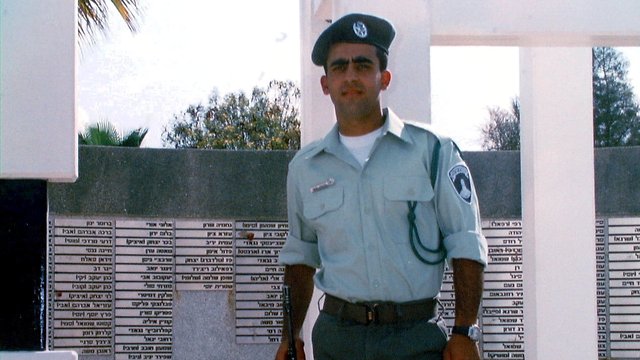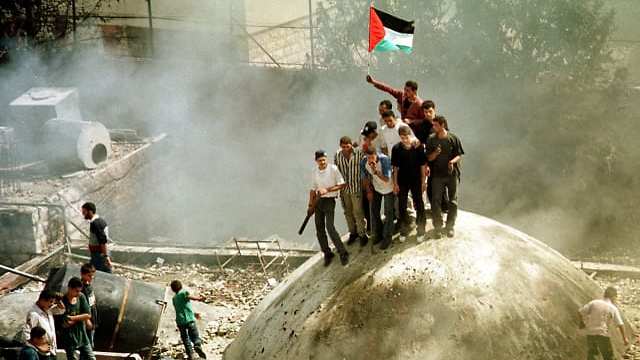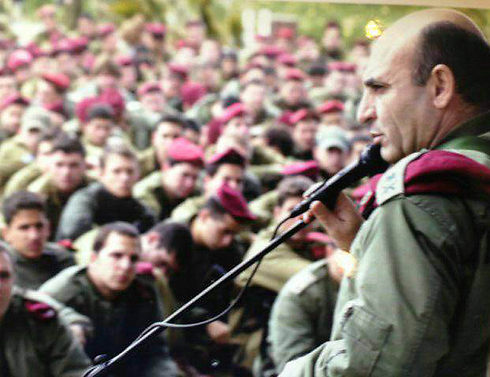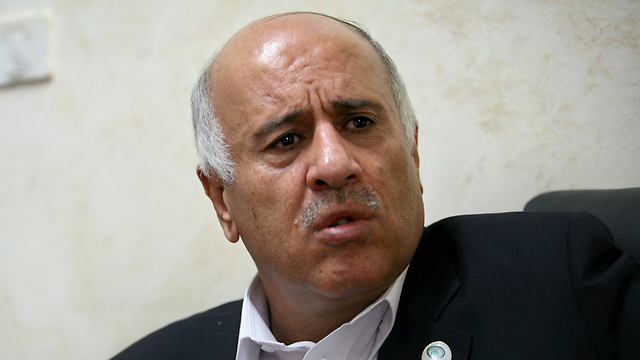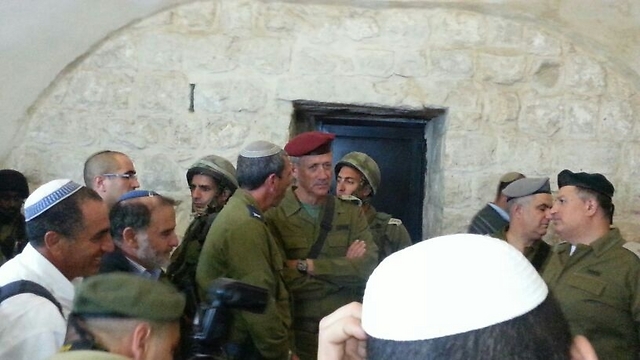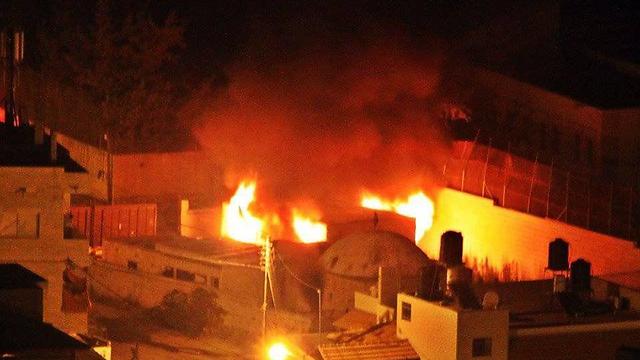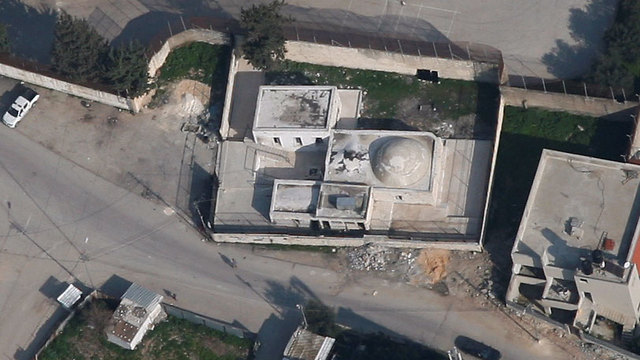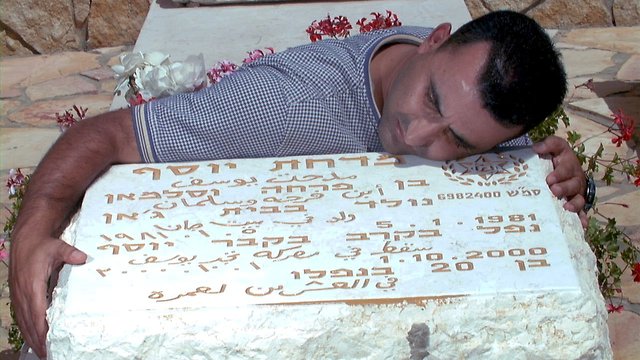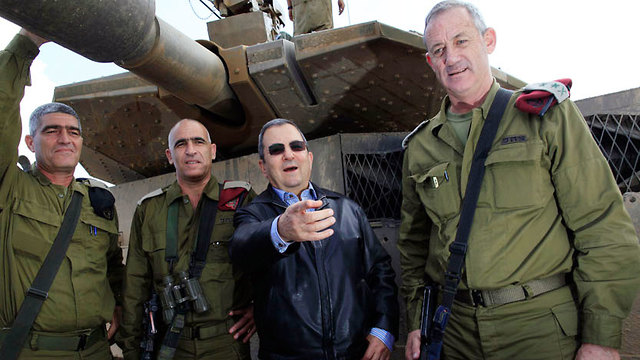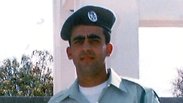
Timeline of tragedy: The death of Madhat Yusuf
At the onset of the Second Intifada, 12 Border Policemen were stationed at the Joseph's Tomb complex in Nablus when a Palestinian mob attacked; the Druze sergeant was shot and bled to death before being evacuated by PA police over four hours later, and his family never forgave Benny Gantz nor the rest of the chain of command involved.
In October 2000, at the start of the Second Intifada, Sergeant Madhat Yusuf, a Border Police officer and member of Israel’s Druze community, bled to death over a period of three and a half hours during an attack by a mob of Palestinians at the complex containing Joseph’s Tomb on the outskirts of the West Bank city of Nablus.
Israel Resilience Party head Benny Gantz, then a brigadier general, was the IDF regional commander during the incident and his handling of the events leading up to Madhat’s death — the IDF asked Palestinian security officials to evacuate the wounded soldier instead of sending in a rescue force — have been heavily criticized by the family and by his political adversaries.
In mid-January of this year, a delegation from the Druze community visited Gantz at his home in Rosh Ha’ayin. Gantz greeted them warmly, declaring that there is a “bond of blood” between them, before proclaiming that he intended to insert changes in the recently passed Nation-State Law so as to be more inclusive toward the Druze, many of whom felt hurt by the law’s wording.
Gantz told the delegation that the current version of the law essentially “stabbed the Druze in the back.” That expression angered Mahdi Yusuf, 49, Madhat’s brother, who accused Gantz of stabbing his brother in the back.
Mahdi stressed that he did not wish for his brother’s death to be used for political purposes, but that the family wanted to make clear that they have not forgotten nor forgiven those they deem responsible.
Not just Gantz. The family considers the entire chain of command —prime minister and defense minister at the time Ehud Barak, then-chief of staff Shaul Mofaz, the Shin Bet top brass and the local military commanders — responsible for abandoning their son and brother. In 2007, when Barak ran for the leadership of the Labor Party, friends and family of Madhat implored voters not to choose him; and in 2011, when Gantz was appointed chief of staff, the family came out publicly against the decision, in vain, for Prime Minister Benjamin Netanyahu nevertheless confirmed Gantz for the position.
Joseph’s Tomb enclave
Madhat Yousef was one of 12 Border Policemen stationed at the Joseph’s Tomb complex when he was killed on October 1, 2000, at the onset of the Second Intifada.
Five years prior, as part of the Oslo Accords, Joseph’s Tomb complex was designated an Israeli enclave within Area A, administered by the Palestinian Authority. The agreement stated that the Israeli security force stationed at the tomb would be a civilian one, not military, and wear no uniform.
A year later, on the eve of the Sukkot festival 1996, the complex was attacked by a Palestinian mob. The rescue force entered the area in open armored personal carriers and was attacked with live fire, losing six of its men. Following the event, the IDF drew up alternative contingency plans in the case of a similar event. One option was to evacuate the complex’s occupants if major disturbances were expected.
The second option, titled Striped Shirt (named for the garment gifted by Jacob to his favorite son Joseph in the biblical Book of Genesis), called for the efficient and rapid rescue of the security force during a violent confrontation.
The two plans gathered dust on the shelves and were never implemented. In May 2000, the complex was again attacked and an officer who was injured was evacuated, after a wait of four hours, by Palestinian policemen led by then-Preventive Security Force chief Jibril Rajoub.
The October 1 attack
The event in which Madhat was killed happened three days after the Second Intifada broke out and 15 Palestinians were killed by IDF forces and dozens injured. When things began to heat up, the IDF commander in charge of the immediate region Col. Yossi Adiri ordered that the settlers from Yitzhar who were staying at the complex for the Rosh Hashanah holiday be evacuated.
Adiri sought to also remove the Border Police stationed there as it was clear that the violence would soon reach the tomb complex and the 12 men would be unable to defend themselves. But Barak vetoed that request, perhaps acceding to appeals by local settlement leaders.
At noon on Sunday, October 1, after the funeral of the Palestinians killed in the previous days’ clashes, the attack on the complex commenced. The commander of the small force inside, Ismail Suwad, said that he initially believed that it was just another clash that would soon blow over. But by 1pm the force found itself facing hundreds of rioters throwing stones, sharp metal objects and Molotov cocktails, as well as firing from multiple directions into the complex.
2:30pm: Senior officers including Commander of the Central Region Maj. Gen. Itzik Eitan and Brig. Gen. Gantz join Col. Adiri at Tel a-Ras hill, overlooking the besieged complex.
3pm: Deputy Shin Bet director Yuval Diskin arrives at the hill after communicating with Rajoub and Fatah National Security Director Haj Ismail, asking them to come to the scene of the riot. Rajoub says that he is on the way but it was later revealed that he procrastinated for some time before heading out.
3:10pm: Sgt. Madhat Yusuf is struck by a bullet fired through a gap in the wall. The bullet enters his body below the left side of his clavicle and exits from the right side of his waist.
“At first I didn’t understand what had happened,” said Arkady Shenderovich who was standing to his right. “Five minutes prior, there was a lull in the fighting and Madhat smoked a cigarette with me and suddenly he was lying on the ground panting for breath.”
3:12pm: A Black Hawk helicopter is dispatched to evacuate the stranded force. Inside the compound, medics connect Yousef to a respirator.
3:15pm: Suwad, the commander at the scene, reports to Col. Adiri that one of their men is severely wounded and needs to be evacuated. He continues to radio for an immediate evacuation every half hour. At this point, the mob has uprooted the concrete barriers surrounding the complex and bypassed the exterior fence, as some of them continue firing into the tomb complex.
4:07pm: Rajoub responds positively to the Israeli request to evacuate the wounded soldier. According to the investigation report, “the Palestinians gave the impression that they were on their way to the site while they had in fact not yet budged.”
4:10pm: Maj. Gen. Eitan orders an armored tank unit to approach the scene.
4:30pm: Col. Adiri instructs a Border Police unit to approach the scene in armored jeeps. But about a kilometer from the site, Brig. Gen. Gantz orders them to halt and not progress any further.
5:10pm: Chief of Staff Mofaz arrives at the Tel a-Ras hill after PM Barak briefs him on the talks with Rajoub.
5:20pm: The unit inside the complex reports that Madhat’s condition is deteriorating and that he has stopped talking to his comrades.
5:30pm: Mofaz orders the helicopters to fire at armed members of the mob. Some officers recommend delaying the order out of concern that the Palestinian police will use the fire as an excuse to leave the scene. Diskin recommends opening fire as it appears that the Palestinian police have joined the mob in firing at the complex.
6:23pm: The helicopters finally open fire and the mob flees.
6:40pm: Sgt. Madhat Yousef succumbs to his wounds. The news shocks the senior officers as they were unaware of the full extent of his injuries, according to the investigation.
“The evacuation force is almost there,” the colonel radios the unit.
“Too late,” responds Suwad.
7:30pm: Four hours and twenty minutes after he was shot, Yusuf's body is evacuated from the complex by Palestinian ambulance.
They didn’t fail; they didn’t even try
The subsequent investigation determined that at no time was there any doubt about the need to evacuate the wounded officer. The only dilemma was regarding the best method in which to do so.
Gantz expressed sorrow at Madhat’s death, but asserted that dispatching a rapid rescue force would have led to many casualties on both sides and that only the commanders at the scene could fully grasp all the considerations.
The committee completed their report two weeks after the incident and found that, based on the circumstances and what the officers knew at the time, the event was handled properly.
Gantz traveled to the Yusuf home to personally deliver the report to the family. When he arrived, the house was filled with journalists and he told them that he couldn’t answer their questions in such a manner. Family members told him that they deserved answers and he must respond to their questions.
At any rate, they didn’t accept the report’s conclusions highlighting that it was unreasonable to depend on the Palestinians, the ones shooting, to be the ones charged with the rescue.
The family was upset that the Striped Shirt contingency plan was not implemented and that the IDF did not take all measures possible to save their son.
“As far as we are concerned,” said Mahdi, “this story is not over. We don’t accept that the military failed in evacuating the wounded. They did not even try.”
The family has maintained their narrative since prior to Gantz’s entry into politics. They lay most of the blame at Barak’s feet. Barak himself said that he assumes all responsibility for what happened but that he left the handling of the situation to the commanders in the field who were best equipped to analyze the situation.
“The criticism stems from the tragic outcome, not because there was any evidence of negligence in the decision making,” Barak said.
In July 2003, an appeal was made to the Supreme Court to order a state inquiry into the incident. It was rejected as the court was convinced that the commanders faced an operational dilemma and not a moral one and that the IDF inquiry was sufficient.
Benny Gantz, as well as Rajoub, Mofaz, Diskin and Galant, declined to be interviewed for this story.
Etti Abramov and Elior Levy participated in this report.










